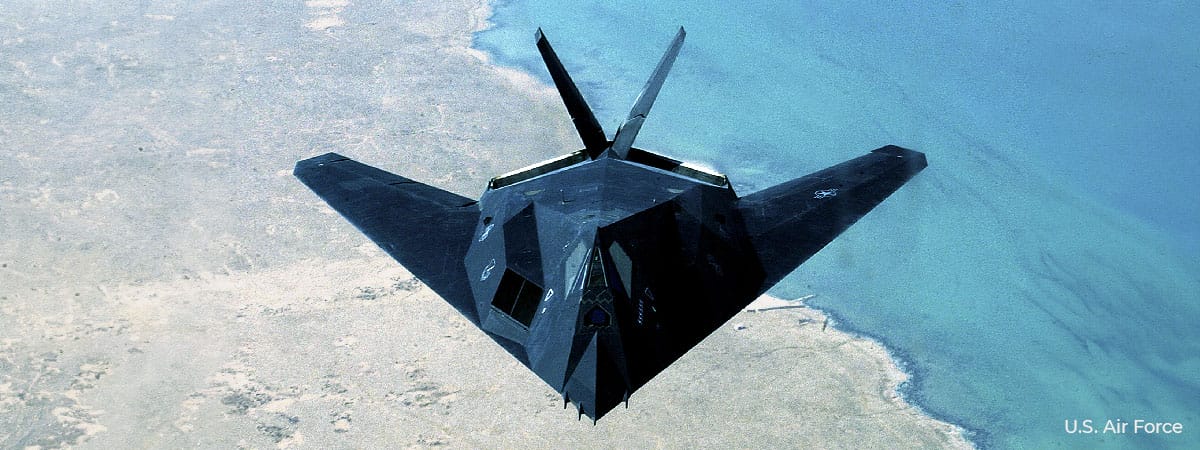The achievement of each milestone over the course of aviation history set the field’s course. Yet how should the success of a plane that completed every mission without existing be classified? The nearly obsolete term UFO (unidentified flying object) is almost appropriate.
Being a ghost with the ability to change the course of an armed conflict has been the ambition of all armies since the end of the 20th century. As we all know, the development of most aviation technology has traditionally been associated with armed conflicts and this case is no different.
The F-117 Nighthawk was a unique aircraft for its kind; its only defence was its invisibility to radars, stealthily flying alone over hostile territory.
But before we pull the sheet off the ghost, you need to understand the requirements an aircraft needs to meet in order to reach this status. To get down to business, this technology is known as stealth in aviation circles. But what does this word mean in a practical sense? In essence, it means that it is undetectable by radar, i.e. radar waves would not detect the object, for which the surface must be faceted to divert or absorb the wave. In other words, parts of the polygon were removed without adding a new vertex.
Curiously, the theory for the development of this aircraft concept was originally explained by a Soviet researcher. It was known that radars had a problem locating objects with faceted surfaces. The problem came about when applying this concept to an aircraft, where aerodynamics is fundamental to stable flight. The aircraft needs not only to be undetectable, but all its cargo must also be undetectable, so an internal cargo hold was designed for bombs and missiles. Engine air intakes also had to be covered with a special grid to reflect waves and reduce infrared detection. At the same time, the various hatches (cabin, landing gear and cargo hold) had to be serrated to maintain this protection. A radar-absorbing coating was also added. Lastly, the aircraft did not carry radar to enhance its stealthiness, preventing it from emitting electromagnetic signals.
One of the initial problems was the conception of a faceted design. Science revealed this real issue for the project, as flight would be unstable for aircraft with this geometry. To counteract this, one of the measures implemented was replacing the manual flight control system with an electronic interface known as fly-by-wire. This provided better control, increasing manoeuvrability and, consequently, reducing instability as it corrected certain flight parameters automatically. All of this led to a considerable increase in aircraft safety.
The Lockheed F-117 Nighthawk was kept a secret from the start, even for the country that created it. Very few people in the United States Airforce (USAF) knew about the aircraft’s existence. In fact, very few pilots were selected to fly this fighter jet, as they had a considerably high number of flight hours. Although the aircraft had been soaring through the sky from the early 80s, its existence was unknown until the late 90s. Its most obvious features were its stealth flight and characteristic black coating. Due to the effort to keep this technology secret, missions in which this aircraft intervened nearly all took place at night. It became invisible not just to radar, but also to the human eye. A genuine flying ghost.
Its main function was to go behind enemy lines undetected, with the objective of reducing the adversary’s strategic defences. It was mainly used to attack land positions. It did not participate in air battle, as its invisible flight allowed it to avoid any altercations. In fact, only one of these fighter jets was ever lost in armed conflict, during the Kosovo War. Despite that loss, its effectiveness was never doubted. It garnered trust in its capabilities and that trust grew over time as it went unscathed in countless successes in various conflicts with no altercations.
Although the project was an undisputed success, the USAF was obligated to officially retire it in 2008 citing the jet’s high maintenance costs and the USAF’s need to update its fleet with new models like the F-22 and F-35. Nonetheless, it is believed that these jets continue to be operated in secret, as they were at the start of the project, because there are active testing operation units. Despite being a first-generation fighter jet and having been replaced by other fifth- and sixth-generation fighter jets with much greater capability, its retirement from the USAF curtailed strategic aerial attacks. The word strategic is important to emphasise. All its missions were to open a land route on enemy territory to safeguard incursions by other units of the armed forces.
However, to specifically discuss stealth aviation technology in the 21st century is to discuss the past, as the majority of modern aircraft include tools to evade detection. However, the capability to be literally undetectable, as the F-117 was in the last decade of the 20th century, is believed to no longer be possible due to advancements in technology.
The concept of stealth aircraft, however, covers more concepts, new technologies and greater overall antidetection efficacy. In fact, work has been done to develop stealthier aircraft to boost strategic effectiveness. This is the case for the new B-21 Raider, the USAF’s latest crown jewel, said to be the most sophisticated aircraft in the world. This is because radar is not the only important consideration in detecting an aircraft, but also key aspects including heat and noise made by the engines, a field in which considerable progress has been made.
It should be noted that all of this will also notably influence civil aviation. Despite this being a military project, much of the technology used by commercial aircraft originated in the defence industry. In fact, one of the major pillars for the aviation industry in the next decade is reducing contamination, with noise, another form of pollution, and impact on our environment being key components in addition to the now well-known goal to reduce the industry’s carbon footprint.
Whether we like it or not, the development of military technology has entailed progress in all industries, including aviation. More efficient and silent engines; lighter, more resistant structures; more efficient maintenance methods and better organised supply chains have been developed, in addition to other improvements. A large portion of the industry argues that this development method is a faster path than traditional development, especially because of the budget allocated and time needed to obtain a response to a technology issue.



